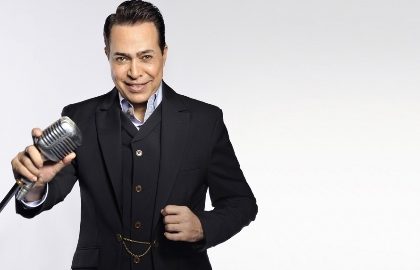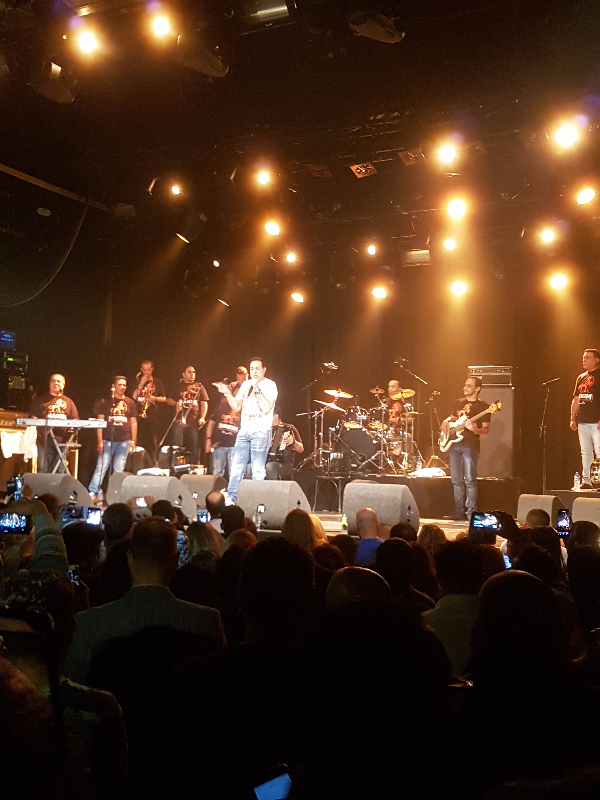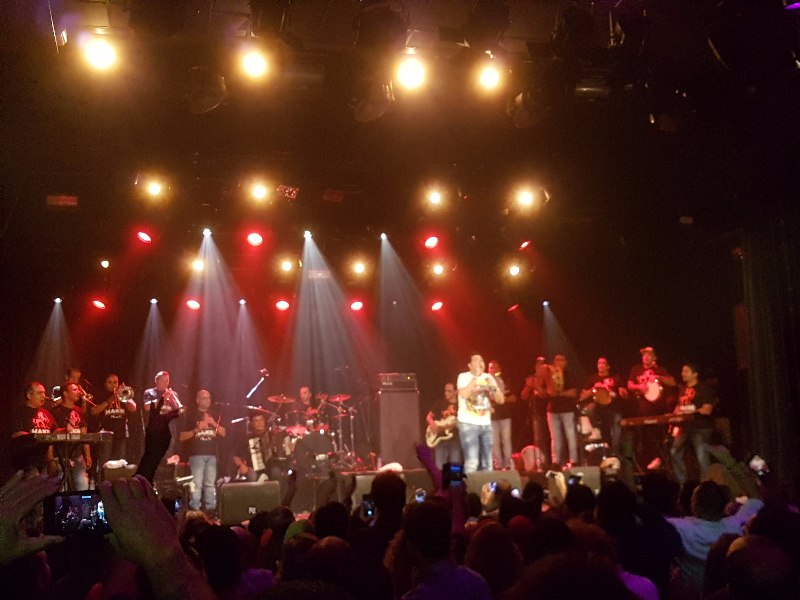Amsterdam – The Egyptian pop star Hakim (aka the Lion of Egypt) gave an unique performance on the 21st of September in the Melkweg in Amsterdam. The announcement of the concert on Melkweg’s website accurately described Hakim as an innovator of both the Jeel, popular youth music style, and the more folky dance Sha’bi. This is a story worth telling as it gives an idea not only about an important chapter in the development of popular music scene in Egypt, but also about how it always relates to and interacts with the different social classes. For decades there has been a musical answer offered to fit the social mobility and changing tastes of different classes. Let’s go briefly over this story before commenting on the fantastic show he gave in the Melkweg.
by Hatim Suleiman
The story begins at the second half of the 1970s. There was a kind of a gap in the popular music market in Egypt. On one hand, the young audience of the urban middle class did not feel attracted to the folkish nightclub music of Ahmed Adaweyah. This music was socially regarded as that of a lower class that has become the nouveau riche.
On the other hand,the times of the long romantic songs with elements of both oriental and western classical and pop music were over[i]. Its greatest star Abdel Halim Hafez died in early 1977. Other stars and composers of this genre were either dead or too old and ill by the late 1970s. This gap in the market was initially filled with Western pop music (Abba, Boney M, Michael Jackson etc. as well as “Mediterranean” pop stars such as Demis Roussos). A new alternative however was gradually developing for this urban middle class audience: a new genre often called Jeel music which literally means “generation” music. Locally in Egypt, the genre was more commonly described as “Shababi / Ughniya shababaia”, which simply means “Youth songs”.
This new pop music genre was similar in form to western pop music and was made by musicians much more at home in western music. The bands main instruments were usually guitars (lead and bass), synthesizer, keyboards, drums and Egyptian percussion drums like the darabouka (more local or eastern instruments were used, but more as guest instruments. The music influences of this new genre and its first stars were remarkably from places far from the dominant center of Egyptian pop music scene in Cairo. Musical influences and stars from North African countries like Libya as well as regional music traditions from for example the southern Nubia and the eastern Suez Canal region made their way into the mainstream light pop music of Egypt.
During the 1980’s, this genre conquered its place to the top and by the beginning of the 90’s it had dominated the Egyptian pop music scene. One of its pioneers, Hamid El Shaeri, became the most successful producer of that time (reminiscent in a way of the producers Stock Aitken Waterman). He developed his own format of the Jeel, a kind of local synth-pop with heavy use of synthesizers, programmed rhythms, catchy keyboards/string lines and call and response vocals, etc.. The more folkish (Shaabi / sha’bi that literally means folk) genre was still popular in its own circles and still the best for dancing in a (wedding) party as it certainly contained a more indigenous and spicy sound but commercially speaking, its best days were gone.
The genius of Hakim (his debut Nazra cassette album came around 1992) was simply combining the two genres. His high tone and “shouting” way of singing, the musical and lyrical folky idiom and performance were delivered over the trusted successful Jeel “Shababi” synthesizer pop format of Hamid El Shaeri (who was the producer of the album). Adding hot pepper to the “jeel” mix, it went viral! Especially coming at the beginning of the partying 1990s.
Twenty-five years -a generation or so- later, Hakim is still touring and roaring. His concert on the biggest stage of the famous pop music venue in Melkweg (or Milky-way) was not sold out but had enough audience to throw an Egyptian party in the heart of Amsterdam. Enthusiastic Arabic audience (and a few Dutch) came in from teenagers to the age of Hakim himself (he was born 1962). Even a couple of families, as you would expect in a real wedding party. Hakim came on stage with the promise that we are all going to have a great party. Spontaneously asking the audience not to be too busy with their mobile phones but to let go and enjoy. Supported by four men on percussion, highlighting the importance of the drums for such a dance party (they also participated in the background dancing), a three men strong brass section added a funky touch, and two on keyboards next to the Egyptian popular instruments accordion and kawala ney (a sort of the Middle Eastern flute).
The promise was fulfilled, the audience and Hakim had a great party for a continuous one and a half hours. Hakim -in a typical Egyptian tradition- stayed very close to the audience all the time, speaking, letting the audience sing and do chorus work, taking requests, dance along, etc. He gave it all from old classics as Beeny we Beenak, Efred to newer trance styles songs, improvising on sha’bi style mawwal. The concert came – typically – to an end at the peak without an encore. Hakim and his band had to pack for a concert at the famous Olympia Theater in Paris two days later. Probably the first Egyptian to perform there since the legendary Umm Kulthum (50 years ago). The fans lingered outside the theater however for another promise of Hakim: a photo with the Lion of Egypt.
Hakim’s website : www.hakimmusic.com
[i] This popular music (1950s-1970s) itself was an earlier answer to a new optimistic rising class adapting to fast modernization (where modernization is typically seen as adopting more western instruments, tools, and techniques).


